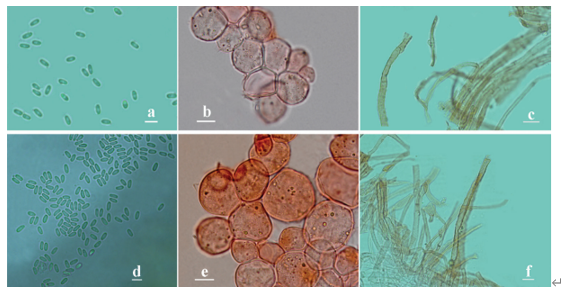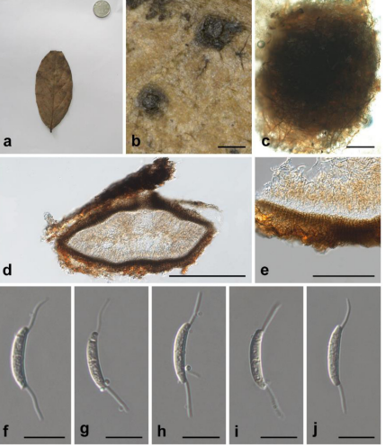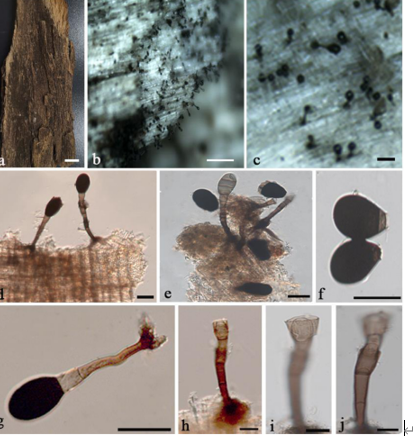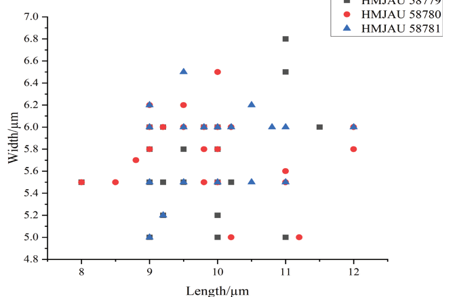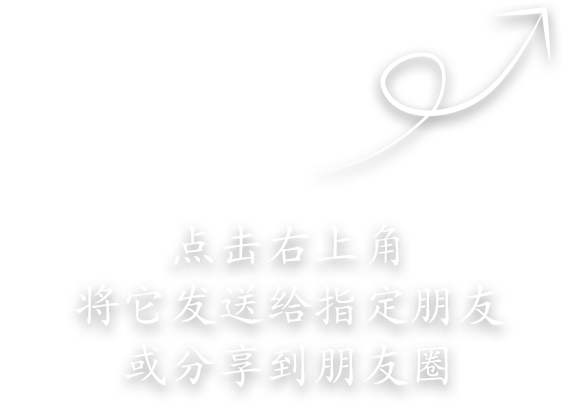Fuscoporia australasica Q. Chen, F. Wu & Y.C. Dai 2020
MycoBank MB 833958; Facesoffungi number: FoF 07995.
Holotype: China, Yunnan Province, Jingdong County, Ailaoshan Nature Reserve, on dead angiosperm tree, 24 Aug 2015, Y.C. Dai 15636 (BJFC 019740).
Morphological description
Basidiocarps – Perennial, pileate, solitary to imbricate, without odor or taste when fresh, hard corky when dry. Pilei mostly dimidiate, rarely circular, projecting up to 6 cm long, 8 cm wide and 1.8 cm thick at the base. Pilear surface reddish brown, concentrically sulcate with zones, velutinate to glabrous; margin obtuse to slightly acute, yellowish brown, up to 5 mm wide. Pore surface honey-yellow to olivaceous buff, glancing, margin narrow, yellowish, up to 2 mm wide; pores circular, 6–8 per mm; dissepiments thin, entire, abundant hymenial setae in tube cavities (under anatomical lens). Context clay-buff, hard corky, about 1 mm thick. Tubes concolorous with pores, hard corky, up to 1.7 cm long.Hyphal structure – Hyphal system dimitic; generative hyphae simple septate; tissue darkening but otherwise unchanged in KOH. Context – Generative hyphae rare, hyaline, thin- to slightly thick-walled, unbranched, frequently simple septate, 2–2.5 μm in diam.; skeletal hyphae dominant, rust-brown, thick-walled with a medium to wide lumen, unbranched, occasionally septate, straight, regularly arranged, 3–3.5 μm in diam. Tubes – Generative hyphae rare, mostly present at dissepiment edges and subhymenium, hyaline, thin-walled, frequently branched and simple septate, 1.5–2.5 μm in diam., some of them encrusted at dissepiment edges and in the hymenium; skeletal hyphae dominant, yellowish brown, thick-walled with a medium to wide lumen, frequently septate, more or less straight, subparallel along the tubes, 2.5–3.5 μm in diam. Hymenial setae subulate, occasionally hooked, mostly originating from tramal hyphae, dark brown, thick-walled, 30–45 × 6–9 μm; fusoid cystidioles hyaline and thin-walled, 9.5–12 × 4–5.5 μm; basidia short clavate to barrel-shaped, with four sterigmata and a simple septum at the base, 9–11 × 5–6.5 μm; basidioles dominating the hymenium, in shape similar to basidia, but slightly smaller.
Spores – Basidiospores broadly ellipsoid to subglobose, hyaline, thin-walled, smooth, IKI–, CB–, some of them bearing a guttule, (3.8–)4–5 × (3.2–)3.3–4(–4.5) μm, L = 4.40 μm, W = 3.88 μm, Q = 1.12–1.15 (n = 90Context – Generative hyphae rare, hyaline, thin- to slightly thick-walled, unbranched, frequently simple septate, 2–2.5 μm in diam.; skeletal hyphae dominant, rust-brown, thick-walled with a medium to wide lumen, unbranched, occasionally septate, straight, regularly arranged, 3–3.5 μm in diam.
Tubes – Generative hyphae rare, mostly present at dissepiment edges and subhymenium, hyaline, thin-walled, frequently branched and simple septate, 1.5–2.5 μm in diam., some of them encrusted at dissepiment edges and in the hymenium; skeletal hyphae dominant, yellowish brown, thick-walled with a medium to wide lumen, frequently septate, more or less straight, subparallel along the tubes, 2.5–3.5 μm in diam. Hymenial setae subulate, occasionally hooked, mostly originating from tramal hyphae, dark brown, thick-walled, 30–45 × 6–9 μm; fusoid cystidioles hyaline and thin-walled, 9.5–12 × 4–5.5 μm; basidia short clavate to barrel-shaped, with four sterigmata and a simple septum at the base, 9–11 × 5–6.5 μm; basidioles dominating the hymenium, in shape similar to basidia, but slightly smaller.
Habitat: angiosperm wood.
Distribution: tropical Asia.
GenBank Accession: ITS: MG008397; nLSU: MG008450; RPB2: MH079402; TEF1: MH636408
Notes: Fuscoporia australasica grows on angiosperm wood in tropical Asia and is characterized by pileate basidiocarps, small pores (6–8 per mm), occasionally hooked hymenial setae and broadly ellipsoid to subglobose basidiospores, 4–5 × 3.2–4 μm. In our phylogeny, three specimens of Fuscoporia australasica form a lineage with strong support (100/100, Fig. 2). Fuscoporia australasica is closely related to F. eucalypti sp. nov. and F. wahlbergii (Fr.) T. Wagner & M. Fisch. (Figs 1–2). Morphologically, these species share the hooked hymenial setae and broadly ellipsoid to subglobose basidiospores; but basidiospores are wider in F. eucalypti than in F. australasica (4–4.5 μm vs. 3.3–4 μm) and F. wahlbergi has globose spores (3.5–4 μm, Reid 1975).
Reference: Chen Q, Du P, Vlasák J et al. 2020 – Global diversity and phylogeny of
Fuscoporia (Hymenochaetales, Basidiomycota). Mycosphere 11(1), 1477–1513, Doi 10.5943/mycosphere/11/1/10 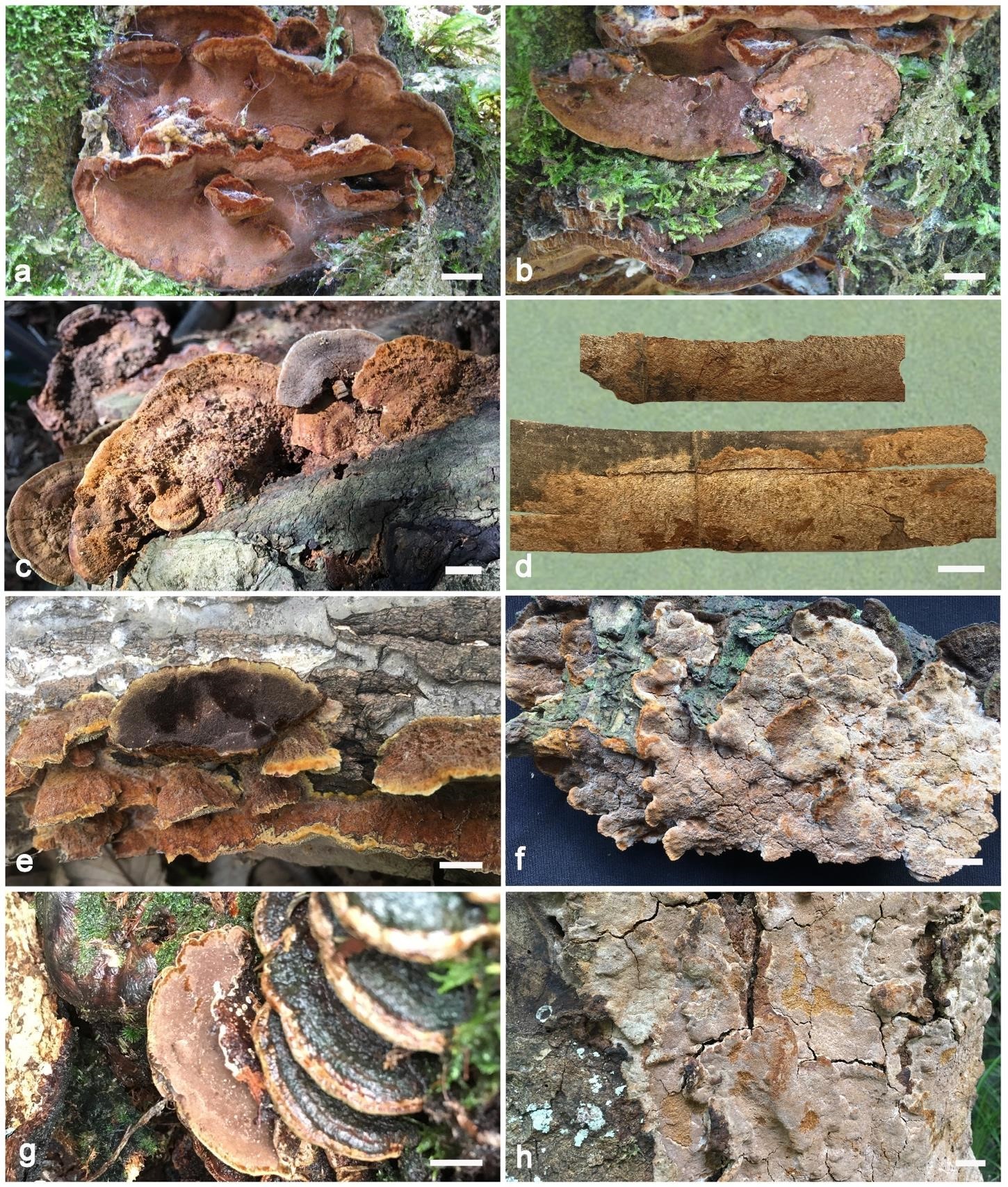
Basidiocarps of Fuscoporia species. a–b Fuscoporia australasica (paratype, Dai 15625). c Fuscoporia australiana (holotype, Dai 18879). d Fuscoporia bambusae (holotype, Dai 16599). e–f Fuscoporia chinensis (e paratype, Dai 17282, f paratype, Dai 17583). g Fuscoporia eucalypti (paratype, Dai 18642A). h Fuscoporia karsteniana (paratype, Dai 17925). Scale Bars = 10 mm.


